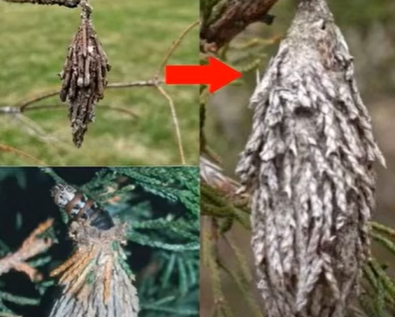If your evergreen trees are thinning or losing needles, you may be seeing the effects of the evergreen bagworm — a small, leaf-eating moth larva often mistaken for another type of insect.
While these pests can cause significant stress to trees, early detection and care can make a big difference. Knowing what to look for helps prevent long-term damage and keeps your landscape healthy year-round.
Bagworms create small, cone-shaped “bags” made from silk, leaves, and twigs that hang from branches.
Hidden inside, the larvae feed on foliage, blending so well with the tree that they often go unnoticed until patches of browning or sparse growth appear. In late spring, eggs hatch and the young larvae begin feeding; by late summer, they pupate inside their bags and later emerge as moths. Males fly off to mate, while females remain on the tree to lay eggs, beginning a new cycle.
As the larvae feed, they strip away leaves and needles that trees need for photosynthesis. This weakens the plant’s natural defenses and may make it more susceptible to stress from drought or disease. Fortunately, with attentive care, most trees can recover. Regular watering, pruning, and balanced soil health help evergreens build resilience against future infestations.
To manage bagworms naturally, inspect trees each season and remove visible bags before new larvae hatch. Encouraging biodiversity by planting a mix of species can also reduce the spread. With consistent observation and gentle maintenance, your evergreens can remain strong, vibrant, and thriving — a living reminder that prevention is the best protection.
